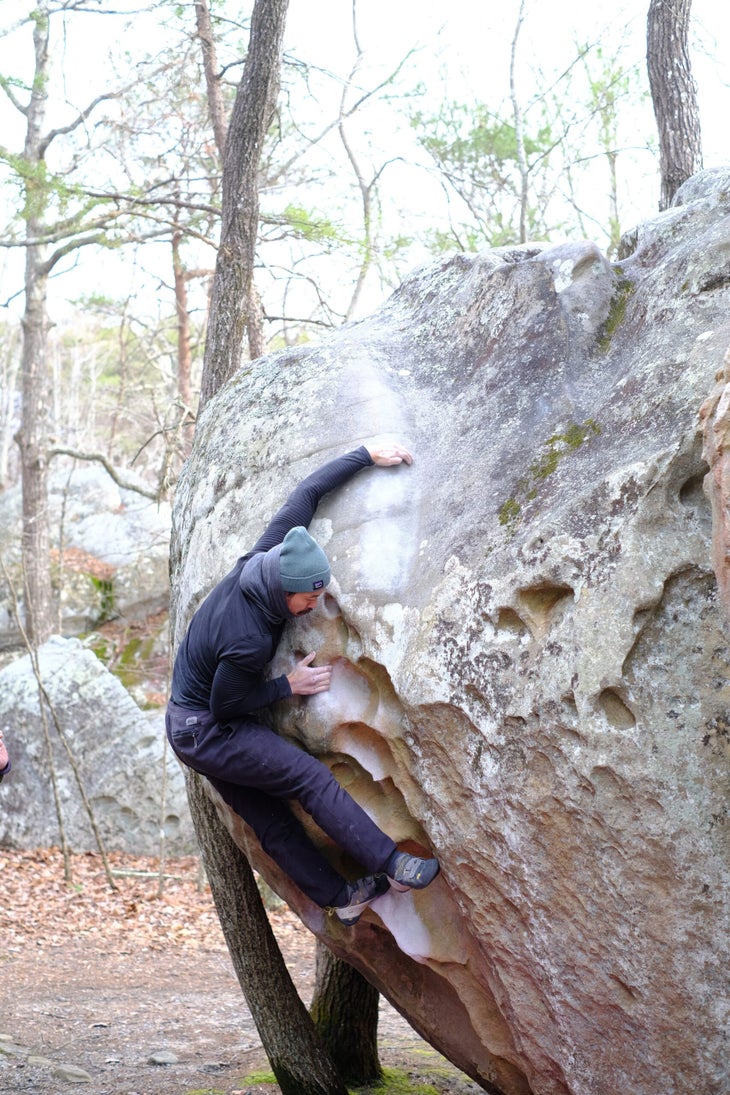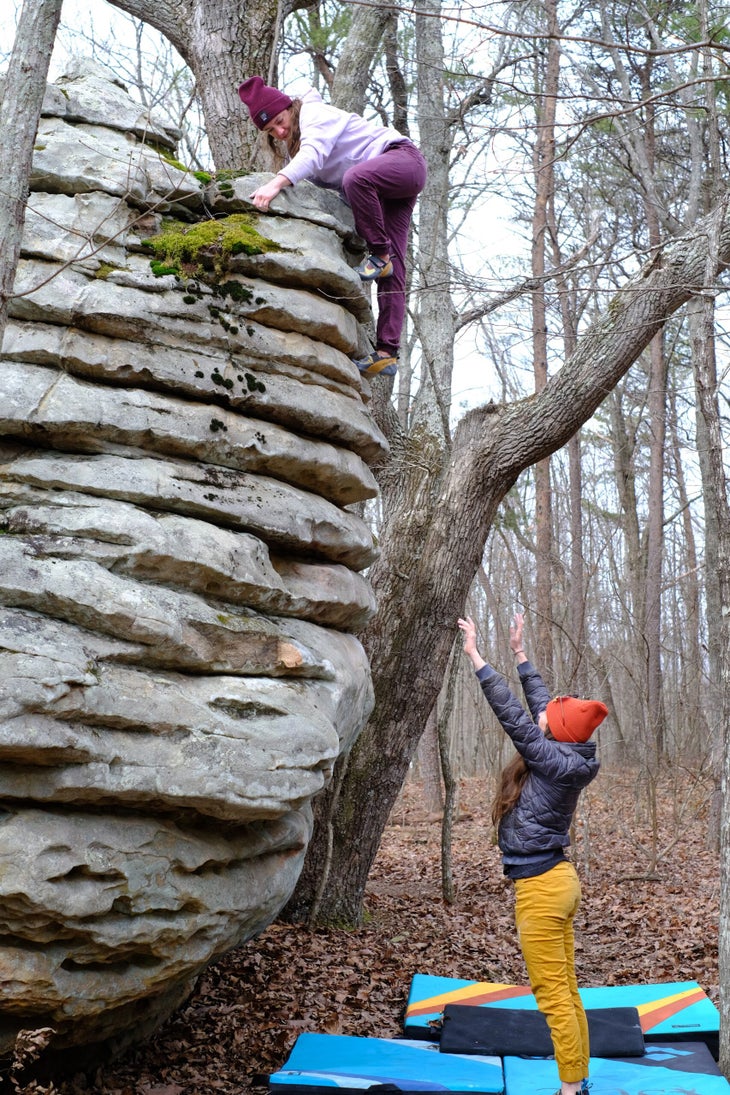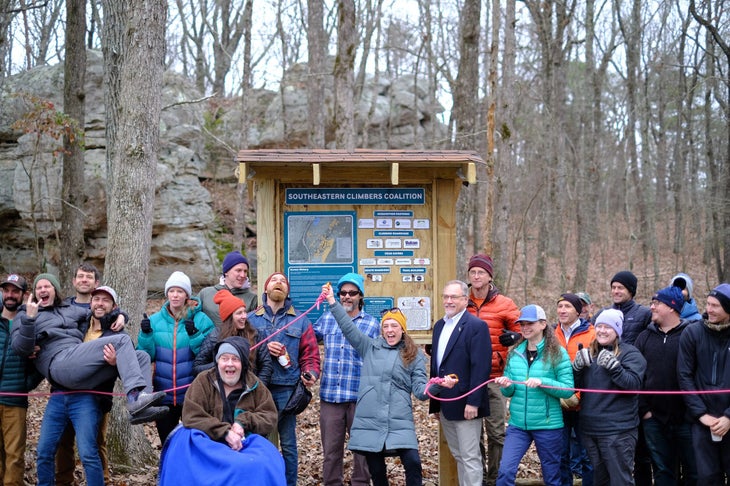Heading out the door? Read this article on the new Outside+ app available now on iOS devices for members! Download the app.
On February 19, the Southeastern Climbers Coalition (SCC) opened the gates of the Citadel, a 58-acre boulderfield in the mountains of northeastern Alabama. The Citadel is home to 150-odd problems on 40 sandstone boulders, and there is plenty of potential for more. The property has a rich bouldering history dating back to the 1980s, but until the SCC acquisition that history was a bit dodgy, because the Citadel—like many of the South’s most famous crags—has always been privately owned.
“The saying goes that we don’t have professional climbers here in the South,” one of the speakers at the SCC’s opening ceremony offered, grinning. “We have professional trespassers.”
As a native, I can attest to this quote. Unlike the West, where you can throw a stone in any direction and hit public land, the South has an awful lot of private property. Rock climbing around here has long been a word-of-mouth affair that involves tiptoeing around landowners and hiding your car behind dense foliage in dirt pullouts.
I began climbing in northern Alabama in the late 2000s, and the access was harder than the climbing.
Searching for rock near me felt like going on a solo mission to Mars. This was partially because I was a teenager without a car, rope, rack, or any other reason for an adult climber to let me tag along. But it was also a result of the scene. The “gym” in Huntsville was a stanky sweat closet in the back of a local rec center, and the outdoor crags that existed were mostly on private land and hush-hush. Aside from a few of the more popular established sites—Palisades Park, Horse Pens 40, Sand Rock—much of my “climbing” consisted of wandering around in the woods looking for moss-covered boulders based on half-bogus directions and free soloing 5.4 choss thinking I was the next Dean Potter.
Even at open, known crags—Sand Rock a prime example—good stewardship was a rarity. Conscientious climbers often shared the crags with redneck goons. Graffiti, ATVs, firecrackers, guns, and too much booze were par for the course. (It was a similar case at the Citadel. By the time the property opened in February, climber volunteers had removed over 2,200 square feet of graffiti from the boulders.)
I once ventured to find a roof cave that a friend’s cousin had told me about, bushwhacking for thirty minutes through poison ivy and a chigger breeding factory, only to find a disintegrating wall that looked like it’d been bolted with gear from Office Depot. Skulking back to my car, crestfallen, I was accosted by an extremely aggressive old man who told me I was on his property and he’d phone the police if I didn’t scram. Another time a buddy and I were handcuffed and shoved into the back of a cop car for thirty minutes of intimidation after scoping out the (admittedly quite loose) rock at a nearby quarry. I was properly arrested at 17 (and nearly had my throat munched on by a police dog) for establishing an urban stemming route up to the third-story roof of my high school with a buddy. (“You been smokin’ that fuckin’ herb, boy?!”)
“Backwoods Access Fund,” the first print story I ever published—which appeared in Rock and Ice seven years ago—was a parody of hair-brained encounters like these.

A historic access push
The Citadel is an extremely high-quality boulderfield, made up of around 10 established sandstone concentrations. There’s plenty of variety, but you can expect much of the slopey, grooved-out style found in nearby Horse Pens 40, along with the tenuous topouts. Popular problems include The Nautilus (V3), which features pinches and grooved pockets leading to a slopey finish; the overhung arete of Big Poppa (V8); slopeladder Ninja Camp (V7); the crimpy face of Earl the Squirrel (V7); and the mighty Snail boulder, home to half-a-dozen eponymous problems (V3-V7) along a dominant snail-like prow. There are also a few offerings from V10 to V13.
Beyond the quality climbing now publicly available, it’s the South’s fraught access history that makes acquisitions like the Citadel so special. “It’s incredible to see how the SCC has come from just trying to do cleanup or trail work to actually purchasing, managing, and protecting crags in perpetuity,” said SCC co-founder Brad McLeod. McLeod has personally eyed the Citadel since the late 1980s, and it’s topped his nonprofit’s “wish list” since its founding in 1993.
Access Fund’s Daniel Dunn remarked on the unique access obstacle in the South. “So much of the land here is private, with no permanent protection,” he said. “This area could’ve been bought and turned into an apartment complex. So the challenge is not just how to secure access, but also to attempt to get some form of permanent protection for climbing.”

In addition to working with private landowners and city, state, and federal governments for access projects across the Southeast, resulting in the protection of over 40 crags, the SCC also owns and manages nine properties directly. “Being a land manager isn’t easy,” Dunn said. “It’s a lot of work.” The benefit of this—and the ironic flipside of the massive quantity of private land in the South—is that when climbers do own the land, climbing access is perpetually protected. Unlike federal land, even legislation out of Washington D.C. won’t affect climbing at SCC-owned properties like the Citadel.
Oftentimes, securing access isn’t about money, power, or drive, but convincing locals that climbers will manage the land well. “The family that originally acquired this property back in the 80s, they did so by being good stewards of the land,” explained SCC marketing director Caleb Timmerman. “They passed the land down the generations. Now, through stewardship again, we’ve secured access and protection for these boulders. So that’s the connecting factor. It’s not finances. It’s not even stoke. It’s demonstrating that we can leave the land better than we found it.”
In the process of preparing the Citadel, SCC executive director Meagan Evans said the group was also given a stellar opportunity to prove to non-climber locals how beneficial it can be to have a climber-owned and managed property in their backyard. All the time and sweat SCC volunteers put into scrubbing graffiti, picking up trash, and building trails didn’t go unnoticed. “Locals have come out and been like, ‘Oh my gosh, you guys have totally changed the landscape,’” Evans said.
Citadel was a particular passion project for Evans. She’s had the project in the corner of her eye for nearly as long as she’s been climbing in the Southeast, and when she took over as SCC executive director in 2021, the Citadel was always in the back of her mind. “The property had sat with the same family for decades,” she said, “and we’ve been sending letters, trying, for years.” No clear tipping point led to access, simply sheer “persistence and patience,” said Evans. “We knocked on a lot of doors, and eventually found the right one. That’s what we do, we keep our finger on the pulse for all the climbing areas in the Southeast so that when those moments come, we’re ready.”
A hub for climbers of all tastes
The Citadel is a great crag, but the real story is that it’s yet another addition to a staggering array of rock in the region. Alabama is often outshined by other Southern hubs—Chattanooga is a couple of hours north, as is the sport of the Red River Gorge and the trad of North Carolina—but Bama has all the makings of a standalone destination in its own right.
The northeast quadrant of Alabama, between Huntsville, Birmingham, and the Georgia border, has a seriously gobsmacking amount of cragging. You won’t find much diversity of rock, as it’s pretty much all sandstone, but you will find high-quality climbing of all disciplines. The region is a “gold mine” in Evans’s words.
Setting base camp in the charming mountain town of Fort Payne (pop. 15,000)—famous as the home of all-star Southern rock band Alabama—gives you access to trad, bouldering, and sport in minutes. A quiet destination, Fort Payne is home to some great food (Tacos Town), coffee (The Spot), and a number of boutique and vintage shops. There’s also a theater dating to the 1930s, hosting a variety of opera, film, and stage productions.
Less than 15 minutes from Fort Payne you have over a hundred boulder problems at the Citadel, dozens of trad lines from 5.7 to 5.11+ at the SCC-owned Jamestown, and several hundred sport routes up to hard 5.13 along the steep walls of Little River Canyon. On that note, LRC is a spectacular outdoor destination in every sense, offering hiking, camping, fishing, and some serious whitewater paddling ranging from Class III to VI. You can also jump the waterfalls if you scout your landing right, but don’t tell anyone you read that here…
Half an hour south of Fort Payne is Cherokee Rock Village, home to the best sport in Alabama, and a nice array of bouldering and trad as well. If you get bored, hop over to Griffin Falls next door. Half an hour northeast is Buck’s Pocket, a newer SCC project that’s still developing and will offer the intrepid climbers the opportunity to establish a few new lines. (Contact the SCC to apply for a development permit.)
Forty-five minutes northeast is Georgia’s Rocktown with several hundred boulders. Another 30 minutes beyond Sand Rock is Hospital Boulders, another SCC-owned property with some two hundred problems, and a bit of trad and sport next door at Noccalula Falls.
If you’re willing to call an hour in the car “local,” as most Colorado climbers do, you’ve got gear lines at the partially-SCC-owned Steele, and some of North America’s finest bouldering at Horse Pens 40 (~400 problems). At this point even the most voracious rock munchers will be tapped out, but there’s still more: Moss Rock (bouldering), Yellow Bluff (sport climbing), and Palisade’s Park (toproping) are all less than 1.5 hours away by car, mostly on beautiful country backroads.
Crowded gyms, empty rock—that’s climbing in North Alabama
Today, my hometown of Huntsville has two High Point gyms, a Trader Joe’s, acroyoga studios, Korean BBQ fusion restaurants, cringey neon lettering that people take pictures in front of, and enough kombucha to give even the most stalwart hippie diarrhea. In short, all the trappings of a yuppie hellscape.
But even though the rock gyms are smashed with folks every night of the week, half of whom seem to be under the age of 11, my “Climbing Mecca!” header is probably deceiving, because the outdoor rock scene in Alabama remains laidback and mellow. Even on weekends, local crags like Yellow Bluff and Rainbow Mountain often host just a few climbing parties.
Alabama may have woeful governance (how about that moronic IVF ruling?), but it still has one of the lowest costs of living in the United States. Yesterday I filled up my motorbike at $2.60/gallon. Not bad.

Climbers can head to the SCC Citadel page to receive a PDF guidebook in exchange for a donation to the SCC.
Author’s Note: The hyperlinks used in this article lead to the SCC’s Climbing Area pages, not guidebook resources like Mountain Project, because the SCC is the best starting resource to understand local access and land use policies. Many of Alabama’s crags, including a few that appear on Mountain Project, are still on private land and/or have nebulous climbing access. I encourage readers to view the SCC’s “Access Notes” on the crag pages before purchasing a guidebook or heading to a topo site to ensure ongoing access projects end in our favor (as Citadel did) and not in closure.
